Tell us a bit about your discovery of photography and influences.
Bryan Schutmaat (BS): I’ve been involved in photography for nearly eight years now, but it feels like less than that. I’m still learning and figuring out new things all the time. There’s not a very fascinating anecdote about how my passion for photography was found. I simply enrolled in a photo course in college because I thought it would be fun. It started as just pure curiosity and turned into something more. I was at first interested in documenting anything around me – my friends, travels, the landscape, strangers in the streets, etc. Influenced by Robert Frank, Winogrand, and the like, those early years were spent with a 35mm SLR and plenty of Kodak Tri-X. Some time later I was turned on to the ‘70s color photographers, then I brought my interest in cinema into photography in subtle ways, and… it’s still evolving.
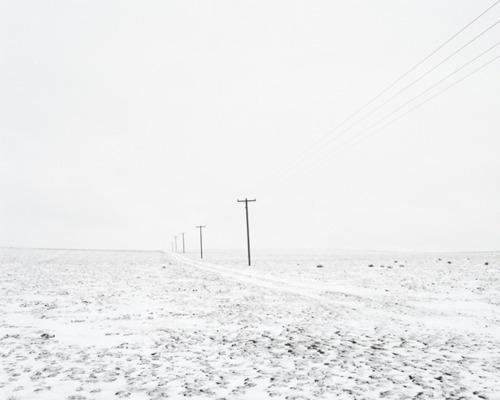
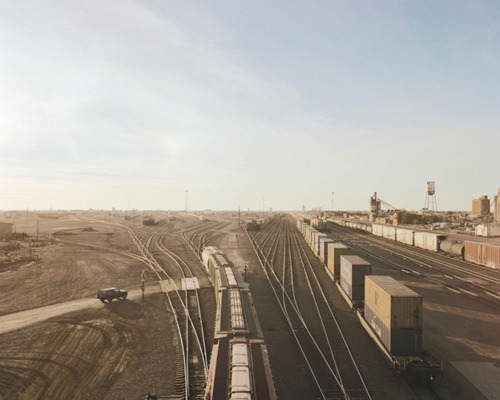
© Bryan Schutmaat from the series 'Heartland'
You hold a degree in History. Do you research the history of an area in order to help create a sense of place?
BS: That would probably be the responsible thing to do, and if I were a different kind of photographer, I could certainly see the benefit of doing some research, but honestly, I don’t make any significant effort to read up on the history of where I’m shooting. It isn’t really necessary. I’m more inclined to read regional literature, or just talk to locals to get a feel for what’s around. Maybe that sounds lazy. But it’s not as though I’m going into it oblivious either. I know where I shoot alright. Firsthand experiences, a general knowledge of the local culture and economy, and what’s overheard in diners is plenty to gain an understanding of a place. Plus, for me, photography at its purest isn’t an academic or intellectual pursuit. I have greater interest in the more heartfelt, intuitive responses to my surroundings, the process of discovery, and the liberty that ignorance and unfamiliarity affords (not total ignorance, of course, but just the right amount). I don’t know if I want all of that to be swayed too much by something I read beforehand, and, as a photographer, I guess I’m more concerned with inventing a sense of place than learning it.
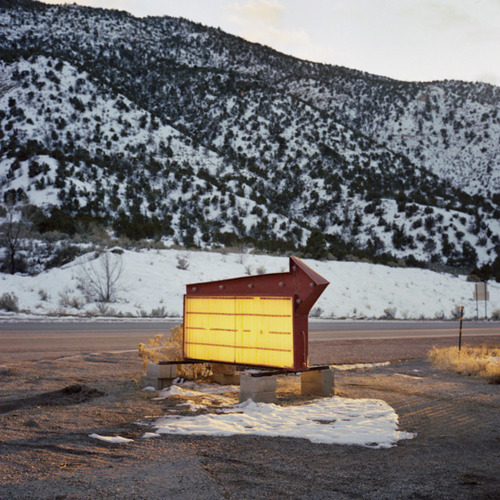
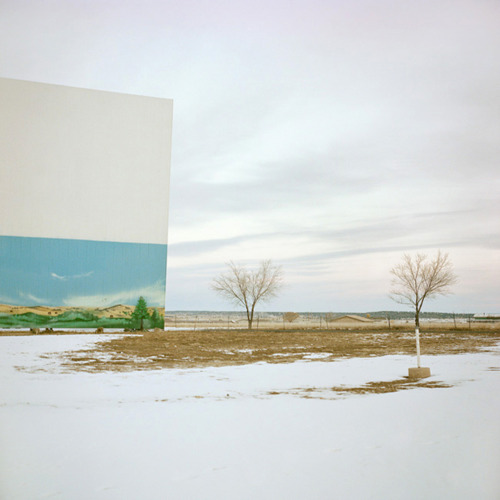
© Bryan Schutmaat from the series 'Western Frieze'
In Heartland and Western Frieze you seem to be interested in geography, in other words the landscape and its influence upon its inhabitants. Can you comment?
BS: Yeah, geography plays big roles in both series. In many regards, Western Frieze andHeartland are two different branches of the same body of work – a lot of crosspollination, but still distinct in their own ways, I’d say. In Western Frieze, I’m dealing with the mystique of the American West and how it’s manifest in what’s seen from the roadside. This western mystique (or whatever it is and whatever’s left of it) is derived from the West’s place in U.S. history as a vast expanse of untamed wilderness. The rugged, geographic characteristics of the landscape formed early opinions about what the West represented, in turn affecting geopolitics and industry and individual lives for years to come. Today, we witness the realization of past expectations. The West is now tame. In the last century or so, as the landscape has been massively cultivated, commercially altered, and as human development chews through wilderness, an irony emerges; the less wild the West becomes, the more we see people glorify the wilderness in pictorial form and in interior settings. It would appear that the marvel of what the West once was has been relegated to pictures on dingy motel walls, or murals on the sides of old buildings. Wagon wheels no longer carry settlers across the open range; they’re hung as light fixtures in cafes. A live elk seems to be a rarer sight than a stuffed one these days. It’s as though people are trying to hold onto something, and I’m interested in finding those vestiges of the past. And there’s no doubt I’m interested in the past, both the historic and less distant. While my work comments on modernity to some extent, there’s something from a bygone era I aim to depict – an interpretation shaped by ‘70s road movies, pop culture, and family trips when I was a kid. It’s nostalgic, I admit. In effort to show some kind of truth, many landscape photographers throughout the medium’s history have sliced right through the romantic characterization of the West, but for a variety of reasons, I like to finesse it, keep it alive in my own way. It’s an attempt at preservation, or propagating myth, which is kind of the crux of the series in more ways than one.
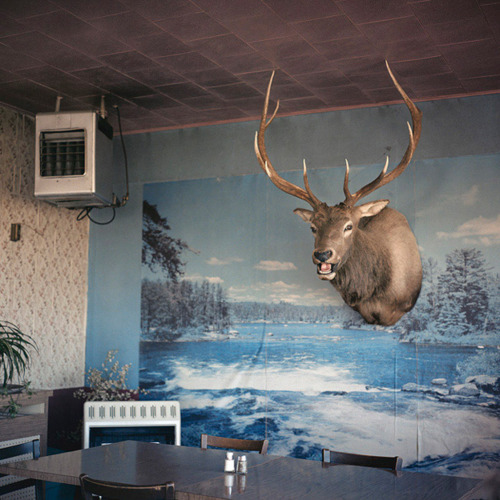
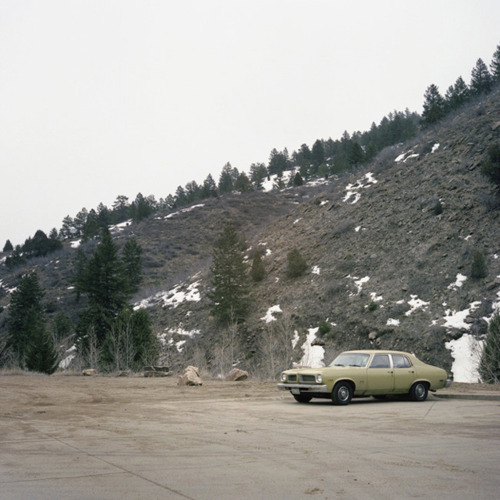
© Bryan Schutmaat from the series 'Western Frieze'
With Heartland, geography was also on my mind, though for different reasons. I was concentrating on the Great Plains, which is some pretty austere terrain. My aim was to convey the culture of the land’s inhabitants by using the stark topography of the area to describe it. There’s a kind of symbiosis; aspects of the land shape the people socially, and the people shape the land physically. This is evident in the architecture, farmland, and townscapes, but even landscapes with little or no sign of human interference functioned well for me within the context of the project, because they’re reflective of the people and they show the surroundings that a handful of Americans encounter daily. I imagine how life would be different for me had I grown up in a different setting, with nothing around save wheat fields and prairie. Looking out at the plains evokes a sense of isolation and the unknown, like looking into the sky at night. That sounds cheesy, but really, it’s a contemplative place for me that stirs up some existential questions. Then there are these churches that emerge from the flatness like monoliths, seeming to be the only things on the horizon that the sun has to shine on. To me, they have a rather menacing presence, but I can see how in a small town, surrounded by those void spaces, churches help fill the emptiness in people’s lives, offering comfort and answers.

© Bryan Schutmaat from the series 'Heartland'
Western Frieze and Heartland can be read as literary in form with recurring themes and visual motifs. Could you talk about the development of each series within these terms?
BS: Yeah, you know, despite my all too lengthy talk above coming from a social/historical angle, I think my pictures are ultimately about the emotive qualities of the landscape. That concern is greater to me than the social emphasis, which I think is often just a pretext to exercise lyricism of some kind. Pictures have got to say something to the heart, and I’m convinced that that’s accomplished by approaching photography in a literary way. Maybe poetic is a slightly better term than literary, but whatever, the idea is to use visual language and stylistic choices to elicit an emotional response in the viewer. Regrettably, much of my interest in this realm has been heightened following the work I did on Western Frieze and Heartland, so I don’t claim any expertise or big achievements using this approach. But as you mentioned, there are some literary elements I was playing around with in both series. In Western Frieze, the theme of travel is really prominent, not only because I thought it would be a good stepping off point for cultural examination, but more so, because I wanted to convey a sense of journey and the rhythm of life on the road, which I think offers emotional substance. There’s a repetition in imagery that I think of almost as verse – road, motel, open landscape, café, road, motel, open landscape, and so on. These settings and their content and tone are meant to relay personal experience. What I encountered while traveling – long drives, waking up in unfamiliar places, isolation, transience, loneliness, the changing landscape over time – was like a recipe for introspection, so I wanted the photos to transmit the feelings I carried with me in those places. Executing that with specificity is tough with photography, so in the end, I think what I got were photos informed by my feelings and intentioned to activate the viewer’s own emotions. The work is like a pseudo-diary, but with all of the plot points and specifics deliberately left out, as if the narrative is always off-screen, and whatever is happening (or has happened or will happen) is up to the viewer. There are further little motifs that pop up, like elks, cars, pictures of pictures, etc, which are there to give the series cohesion and further define the western locale. The snow motif was somewhat arbitrary, but definitely a mood builder, and it complimented the homophonic title in a poetic kind of way.
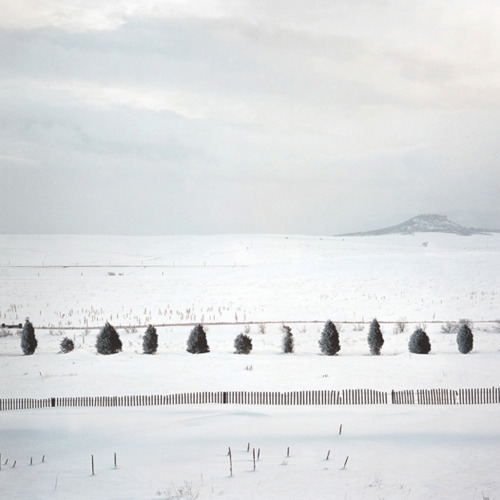
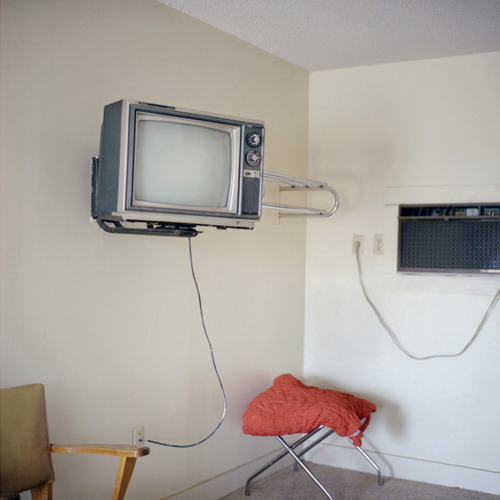
© Bryan Schutmaat from the series 'Western Frieze'
Heartland is also narrated from the perspective of a traveler, although it’s less explicit. That wasn’t my intent at first, but again, a sense of journey yields emotional assets that I didn’t want to neglect. In Charles Portis’s road book, The Dog of the South, the protagonist says, “Tiny things take on significance when I’m away from home.” I feel similarly. Wandering, exploration, and contemplation, which for me are inherent in travel, are integral to my process and end product, and I feel like that’s felt in the work to some capacity. Also similar to Western Frieze, much of what I said above about insinuated narrative applies to Heartland. Without actually showing them, I wanted the presence of the people who occupy the landscapes to be felt in an evocative way, as though they’re unseen characters whose realities viewers can immerse themselves in and ponder. A stack of hymnals on a piano, or a ribbon tied to a stop sign, has traces of vague stories and provides mystery, and with photography, I think narrative dwells in mystery. Perhaps the most salient thematic component in Heartland is the Christian content, especially the churches, which repeat every several pictures, invariably adorned with a bold cross. I talked in my prior response about my fascination with religion on the plains and why I sought to address it. If the series were a song, I’d think of the church pictures as the choruses. They’re louder than the other photos, yet ambiguous, and they’re reminders of the kind of culture we’re dealing with.
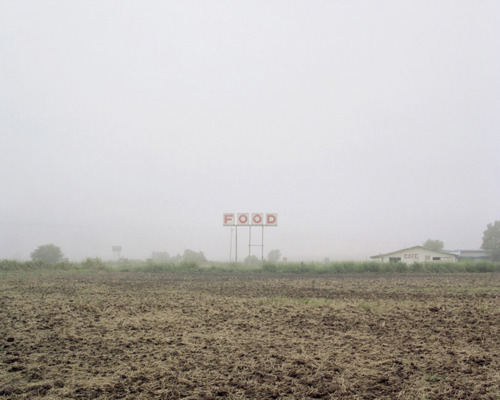

© Bryan Schutmaat from the series 'Heartland'
These pictures seem to be organized in book form. Are you planning on publishing?
BS: At this point, I’m worn out on Western Frieze and Heartland, so I don’t have hopes of publication for either of those series. But I do want to make a book in the future. I began photography with few expectations (in fact, the idea of someone wanting to interview me is still surprising), but I’m starting to get way more ambitious, putting more confidence in my dreams and so on. I have some work in the oven right now that I’d like to publish at some point. And I should mention that it’s important to me to put out a book, because in my opinion, books are the optimal way to interact with photography. I know the best, deepest experiences I’ve had with pictures have been with books. When you’re viewing a book, it’s an intimate experience. You’re not in a clinical gallery setting. You’re typically at home, where no one’s around, like the lights are off in the theatre and you’re free to engage as much as you want.
---
LINKS
Bryan Schutmaat
United States
share this page
